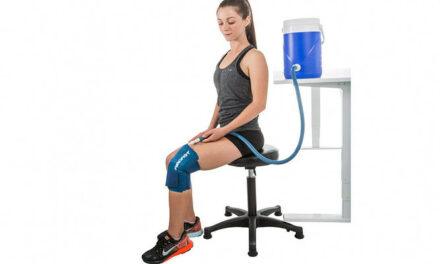Interferential Current (IFC) and Transcutaneous Electrical Nerve Stimulation (TENS) are both electrotherapy technologies used in treating people who are affected with chronic pain.
They send a low level of current stimulus into the body through their electrodes’ that are glued to the body.
Understanding how they both function and their differences will help to give you an idea on the level of their effectiveness in managing different types of pains.
Before further due, let’s work out what really Interferential Current or IFC Electrical Stimulation means.
What is IFC Electrical Stimulation?
Interferential current therapy (IFC) is an effective therapeutic option often used in physiotherapy clinics to relieve chronic pain.
Interferential current (IFC) alters the pain signals that move to the brain from the injured tissues by merging 2 low-frequency electrical pulses down inside the affected tissues generating a 3rd frequency which brings about the interruption.
IFC reduces the pain and boosts blood circulation within the affected tissues.
How Interferential Current (IFC) Works?
Interferential current comes with electrodes’ that are placed around the injured parts of the body. The IFC device then transfuses electrical impulses through the electrodes’ placed on the skin into the body which stimulates the nerves and underlying tissue.
These electrical impulses do not harm or pain. Patients often describe the IFC stimulation feeling like a slight prickle on the skin.

The IFC frequencies have been proven to be stimulating endorphins (natural pain killers in the body). So, IFC promotes free medication, self-healing process.
Tip: IFC is different from Direct Current Stimulation (DCT), which commonly used in the management of depression.
What is IFC used for?
Interferential current (IFC) is used to stimulate nerve tissue to stop muscle spasms, relieve pain, reduce swelling, support healing and increase blood flow.
This technology also is used to treat various muscles, nerve, and soft tissue injuries or diseases such as;
- Osteoarthritis
- Rheumatoid arthritis
- Sciatica
- Back pain
- Neuralgia
- Migraines/headaches
- Post-surgery (recovery after surgery)
- Sports injuries (Air Relax Leg Compression and LX7 Max Sequential Air Compression can help to recover fast from sports injuries and fatigue)
- Circulatory disorders
IFC is also helpful in the treatment of edema, inflammation and stiffness of joints. People with health challenges such as joint injuries, body pain, cumulative trauma disorder, or pre- or post- orthopedic surgery find interferential current therapy as an essential option.
The devices based on IFC have been helping many patients for years, and so many research reports and case studies have documented the effectiveness of it in treating diverse health challenges, boosting the healing process and increasing blood circulation.
Patients who undergo IFC therapy record lesser complaints compared to others who exclusively rely on drugs for pain relief.

Saying so, like any other medical device, there are several possible side effects of IFC you should keep an eye for.
Tip: Follow the link for MediChannel Electrical Muscle Stimulation (EMS) and TENS Selection Guide for different types of pains.
Some possible side effects of IFC
There is usually no serious side effect directly from the interferential current application.
Normally, the electrodes’ are used with a wet sponge that is placed between the skin and the electrode. If there is any discomfort, it is because the sponge is not moist enough or perhaps the electrode is not entirely covered by the sponge and therefore having some direct contact with the skin.
Some users may experience some kind of ‘pins and needles’ or tingling sensation at the sponge contact area during the treatment. This sensation may linger for a particular time, perhaps a short period after the treatment too.
The current intensity can be increased according to the user’s comfort. Usually, a stronger current has more positive effects, but it should not be too high as to hurt the user.
Knowing more about IFC, now let’s move on to explore more about TENS, also known as Transcutaneous Electrical Nerve Stimulation.
What is TENS?
Home-use devices based on TENS (transcutaneous electrical nerve stimulation) are battery-powered and used for treating pain.

A TENS device comes with electrodes’ through which it delivers small electrical impulses into the body when they are placed on the skin. When these electrical impulses are transferred into the body, they overflow the nervous system, minimizing its power to convey the signals of pain to the brain and spinal cord.
Also, like by the IFC, the electrical impulses at the same time stimulate the body to produce endorphins (body natural pain killer).
A TENS device might be a solution for pain relief, especially when conventional methods of pain relief couldn’t yield a better result.
The TENS device is best used only based on doctors or health professional advice. It is not meant for all conditions or all types of pain.
Other painkillers or treatments may be tried first before making use of the TENS device, or it can as well be used together with other painkillers.
A TENS device is controlled personally by the user, which means it can be adjusted individually without visiting a medical professional. Usually, a device could be used many times daily, but up to 15-20 minutes for a session.
Transcutaneous electrical nerve stimulation (TENS) devices can alone be used together with other treatments in treating many types of pains and pains associated with certain health conditions.
What is TENS used for?
Transcutaneous electrical nerve stimulation (TENS) is used in treating the following symptoms
- Labor pain
- Period pain
- Joint pain
- Post-surgery pain
- Back and neck pain
TENS devices may also help to alleviate the pain that comes from the following conditions.
- Arthritis
- Endometriosis
- Sports injuries
- Fibromyalgia
- Multiple sclerosis
- Spinal cord injury
- Painful diabetic neuropathy
Tip: Here’s our article about TENS placement for Sciatica pain.
What are the Key TENS Settings
Transcutaneous electrical nerve stimulation machines are seen to be working in two different ways.
1. When the device is set on a high pulse rate (the standard way of use) of 90-130 Hz
At this setting, the device generates electrical impulses that block the pain signal from going to the brain.
According to the pain gate control theory, the brain and the nerves of the spinal cord, which controls the nervous system has a gate mechanism. The pain signal moves to the brain when the gate is open, and it makes us feel the pain. But when the gate is closed, the pain signals are restricted and wouldn’t be able to get through to the brain, and then no pain will be felt.
Transcutaneous electrical nerve stimulation (TENS) devices stimulate some nerves that do not carry pain to close the gate. Therefore, the brain will be busy with the quick signals from the TENS device instead of the slower and more painful signals the body receives elsewhere. That is the reason rubbing on the injured area can reduce the pain temporarily.
2. When the pulse is set low (2-5Hz)
At this setting, the TENS device stimulates the body to generate its pain reliever known as endorphins. This chemical works the way morphine works in blocking pain signals.
Who can and cannot use TENS?
The TENS is mainly used to help alleviate pain in the muscles, nerves and joints, which are also known as musculoskeletal pains.
This device does not work better in abdominal, head or chest pains.
TENS devices do not have any considerable side effects as there are from the medications (e.g. pain killers).

Nevertheless, the following people must not use a TENS device.
- People wearing a pacemaker.
- Pregnant women (unless during the period of labour or based on a specific medical aid).
- People with epilepsy or other types of neurological diseases.
- People with heart diseases.
- When the pain is not diagnosed, or when the cause of the pain is uncertain.
Like with any other device and pharmaceutical, there are some possible side effects of TENS.
Possible adverse events from TENS
The use of the TENS device is safe for many people and the most experience no side effects.
Nevertheless, for some TENS may produce electrical impulses that may cause prickling, buzzing or tingling sensation, which many people are not comfortable with.
Some people may dislike the gummy pads.
It is vital not to use the electrodes’ on the eyes or the neck. Using electrodes’ on the neck is capable of causing spasms and lowering blood pressure. When placed on the eyes, the pressure within the eye can be increased and possibly results in injury.
Tip: Did you know the differences between Alpha-Stim and TENS in treating Pain, Anxiety, Depression and Insomnia? We have covered that in another article. Just follow the link to read more.
What is the Difference Between IFC and TENS?
IFC (inferential current therapy) and TENS (Transcutaneous electrical nerve stimulation) are both treatments that use electric current in treating long-term unruly pain and other pains.
Both procedures were seen to be a harmless and productive substitute for conventional treatment for pain relief.
They both have a slight side effect but are non-addictive.
Both modern IFC and TENS devices are easy to carry and convenient to use.
However, IFC and TENS have their differences which are listed below.
- IFC makes use of inferential electricity stimulation that focuses at the electrodes’ intersection point while TENS stimulates the whole current that can move to the electrodes’ placed on the body.
- The primary function of IFC is to block the signal of pain on peripheral nerve fibres, but the electric reactions of the TENS unit are for the motor nerve and sensory fibres.
- Usually, IFC delivers at 4000Hz, but TENS modulates at a lower frequency often at 125H3.
- IFC delivers electric current more comfortably than TENS.
- IFC reaches more favorably depth and also provides electrotherapy to more tissues than TENS.
- IFC can stimulate blood circulation while TENS stimulates the production of endorphins.
- IFC is meant to control pain, inflammation, edema, which is usually a result of trauma, but TENS only treats low-risk conditions like back pains.
- IFC also helps to stimulate healing and tissue restoration, but TENS focuses only on pain control.
Conclusion
In as much as interferential current (IFC) and Transcutaneous electrical nerve (TENS) are both electrotherapy devices used in the treatment of chronic pain, they have their differences. The current frequency which IFC delivers is higher and penetrates the tissue without much discomfort and deeper than TENS current frequency, in addition to many more differences noted above.
Understanding these differences will help the potential user to make the most desired choice.
Tip: Here’s MediChannel Electrical Muscle Stimulation (EMS) and TENS Selection Guide
for different types of pains.



![Can Rooke Vascular Boots Truly Help With Leg Ulcers And Wound Healing? – A Complete Rooke Boot Heel Float System [HFS] Review](https://themedichannel.com/wp-content/uploads/2020/02/rooke-vascular-boots-440x264.jpg)






Recent Comments